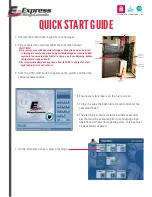
Commissioning
Leuze electronic
OGS 600
66
TNT
35/7-2
4
V
8.3
CANopen communication protocol
8.3.1
General information on CANopen
8.3.1.1
Topology
The CAN bus is a serial 2-wire bus system to which all participants are connected in parallel
(i.e., using short stub cables). To avoid reflections, the bus must be terminated with a termi-
nating resistor of 120ohm at each end of the trunk line. Terminating resistors are also
required for very short trunk line cable lengths.
8.3.1.2
Bus line (trunk line)
For CAN, the maximum cable length of the trunk line is predominantly limited by the signal
propagation time. The multi-master bus-access process (arbitration) requires that the
signals are present virtually simultaneously at all nodes/participants. Therefore, the cable
length of the trunk cable must be adapted to the baud rate.
Table 8.13:
CANopen bus length in relation to baud rate
8.3.1.3
Address assignment
Each participant connected to CANopen is assigned its own address (Node ID). Up to 127
participants can be connected to one network. The addresses range from 1 to 127. The
address 0 is usually reserved for the CANopen master.
The node ID can be set in two ways:
• Via the object directory:
• Via the
Layer Setting Services
function (LSS, see DS305 of CiA).
Baud rate
Bus length
1Mbit/s
< 20 m
500kbit/s
< 100 m
250kbit/s
< 250 m
125kbit/s
< 500 m
50kbit/s
< 1000 m
20kbit/s
< 2500 m
NOTE
The participant-specific address for CANopen is also called the
Node ID
. Throughout this
handbook, the term "address" is used, which is identical to Node ID.
Index
Sub-index
Name
Description
Length [byte]
Data type
2001
h
[1
h
]
Can Node No
CAN node address
2
uint16















































